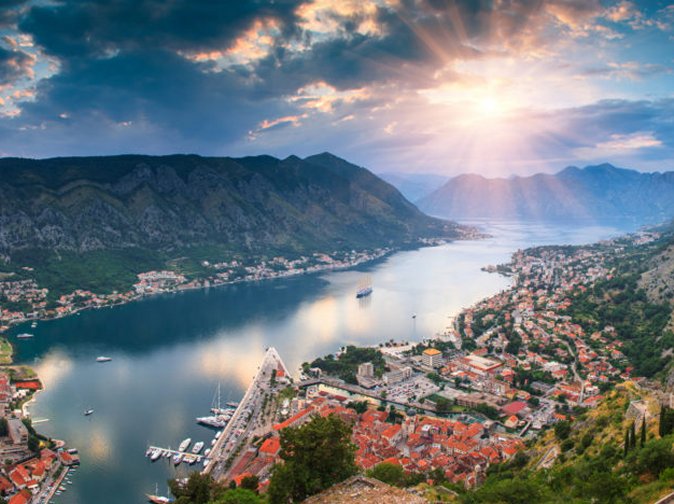

KOTORSince the early 2000s Kotor has seen an increase in tourists, many of them coming by cruise ship. Visitors are attracted by the natural environment of the Gulf of Kotor and by the old town of Kotor. Kotor is part of the World Heritage Site dubbed the Natural and Culturo-Historical Region of Kotor.The fortified city of Kotor was also included in UNESCO's World Heritage Site list as part of Venetian Works of Defence between 15th and 17th centuries: Stato da Terra – western Stato da Mar in 2017. The exact time of foundation of the first settlement is not known. According to some sources, the oldest settled area dates two millennia back, and its current name stems from the word Dekatera (from the old Greek words "Deka + Thira" meaning "Ten" + "Gate", probably from the number of gates of the fortification).
Roman era
Middle Ages In 1002, the city suffered damage under the occupation of the First Bulgarian Empire, and in the following year it was ceded to Duklja by the Bulgarian Tsar Samuil. Duklja, or Dioclea, was a vassal duchy of Byzantium at the time.The local population resisted the pact and, taking advantage of its alliance with Dubrovnik, maintained its high autonomy. During this time, the small romanized Illyrian population of Kotor was slowly assimilated by a significant Slav population coming from neighboring areas. Duklja, the biggest Serb duchy at the time, gradually became more powerful under Vojislavljević dynasty and eventually independent from Byzantium in 1042. The city remained autonomous up until Duklja was once again subdued by Byzantium in 1143. |
 |
 |
The city was conquered in 1185 by Stefan Nemanja, the ruler of the Grand Principality of Serbia and founder of the Nemanjić dynasty. At that time Kotor was already an episcopal see subordinated to the archbishopric of Bari, and in 13th century, Dominican and Franciscan monasteries were established to check the spread of Bogomilism. Under the rule of the Nemanjić Kotor became a partially autonomous city, enjoying many privileges and maintaining its republican institutions. This is backed by a statute from 1301, which demonstrates that Kotor had the status of a city under Serbian rule. In the 14th century the commerce of Cattaro, as named in Latin scripts, rivaled that of Republic of Ragusa, and caused the Republic of Venice to be envious. Kotor remained the most important trading port of subsequent Serb states – Kingdom of Serbia and Serbian Empire, up to its downfall in 1371.After the fracturing of the Serbian Empire, the city was taken by the Kingdom of Hungary, only to change hands repeatedly between them and the Republic of Venice in the period between 1371–1384. After that, Kotor was held by the Kingdom of Bosnia under Tvrtko I Kotromanić between 1384–1391. The king of Bosnia, who claimed the Serbian throne, minted his coins in Kotor. After the death of Tvrtko in 1391, Kotor became fully independent, until the administration, wary of the looming Ottoman danger, asked the Republic of Venice for protection. The city acknowledged the suzerainty of the Republic of Venice in 1420.
Venetian and Ottoman rule |
 |
 |
Habsburg and Napoleonic ruleAfter the Treaty of Campo Formio in 1797, it passed to the Habsburg Monarchy. However, in 1805, it was assigned to the French Empire's client state, the Napoleonic Kingdom of Italy by the Treaty of Pressburg, although in fact held by a Russian squadron under Dmitry Senyavin. After the Russians retreated, Kotor was united in 1806 with this Kingdom of Italy and then in 1810 with the French Empire's Illyrian Provinces. Kotor was captured by the British in an attack on the Bay led by Commodore John Harper in the brig sloop HMS Saracen (18 guns). To seal off Kotor, residents along the shore literally pulled the ship in windless conditions with ropes. The Saracen's crew later hauled naval 18-pounder guns above Fort St. John, the fortress near Kotor, and were reinforced by Captain William Hoste with his ship HMS Bacchante (38 guns). The French garrison had no alternative but to surrender, which it did on 5 January 1814. It was restored to the Habsburg Monarchy by the Congress of Vienna. Until 1918, the town, then known as Cattaro, was head of the district of the same name, one of the 13 Bezirkshauptmannschaften in the Kingdom of Dalmatia. In World War I, Kotor was one of three main bases of the Austro-Hungarian Navy and homeport to the Austrian Fifth Fleet, consisting of pre-dreadnought battleships and light cruisers. The area was the site of some of the fiercest battles between local Montenegrin Slavs and Austria-Hungary. After 1918, the city became a part of Yugoslavia and officially became known as Kotor.
World War II
|
 |
 |
Main sightsKotor has one of the best preserved medieval old towns in the Adriatic and is a double Unesco World Heritage Site: it is part of Natural and Culturo-Historical Region of Kotor and Venetian Works of Defence between the 16th and 17th centuries: Stato da Terra – western Stato da Mar. It is home to numerous sights, such as the Cathedral of Saint Tryphon in the old town (built in 1166), and the ancient walls which stretch for 4.5 km directly above the city. Sveti Đorđe and Gospa od Škrpijela islets off the coast of Perast are also among the tourism destinations in the vicinity of Kotor.
Culture Kotor has a large population of cats that have become a symbol[citation needed] of the city. The city has several cat stores and a cat museum, as well as the Cats' Square (Trg od mačaka). Water and food is left throughout the city for the cats to feed on, and cardboard boxes are often arranged to be a place for the cats to sleep in. |
 |
 |